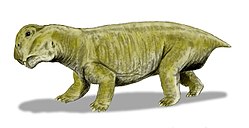| Tropidostoma | |
|---|---|
 | |
| Tropidostoma dubium (SAM-PK-K11238) in (A) dorsal, (D) ventral, (G) right lateral, and (J) anterior views. Bulbasaurus phylloxyron (CGP/1/938) in (B) dorsal, (E) ventral, (H) right lateral, and (K) anterior views. Specimen has suffered some lateral compression. Scale bars equal 5 cm. | |
| Scientific classification | |
| Kingdom: | Animalia |
| Phylum: | Chordata |
| Clade: | Synapsida |
| Clade: | Therapsida |
| Clade: | † Anomodontia |
| Clade: | † Dicynodontia |
| Family: | † Oudenodontidae |
| Genus: | † Tropidostoma Owen, 1876 |
| Species: | †T. dubium |
| Binomial name | |
| †Tropidostoma dubium Seeley, 1876 | |
| Synonyms | |
| |
Tropidostoma is a medium-sized herbivorous oudenodontid dicynodont therapsid that lived during the Late Permian (Lopingian) period in South Africa. The first Tropidostoma fossil was described by Harry Govier Seeley in 1889. Later two subspecies were identified. Tropidostoma fossils are an index fossil in a biozone of the Karoo Basin known as the Tropidostoma Assemblage Zone. This biozone is characterized by the presence of this species in association with another dicynodont species, Endothiodon uniseries . [1] [2]





